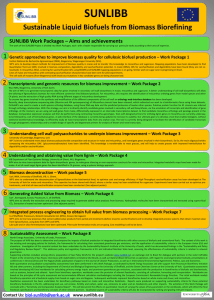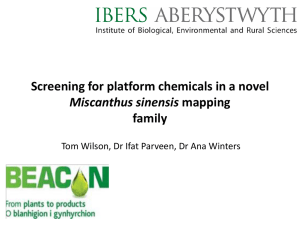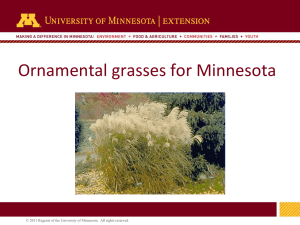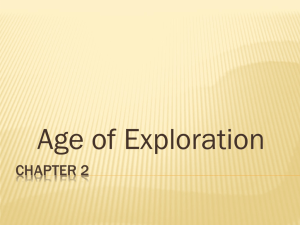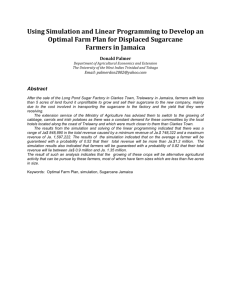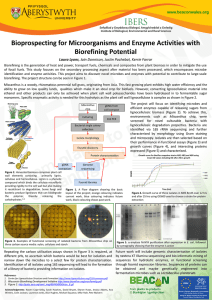Joint Deliverables Report
advertisement
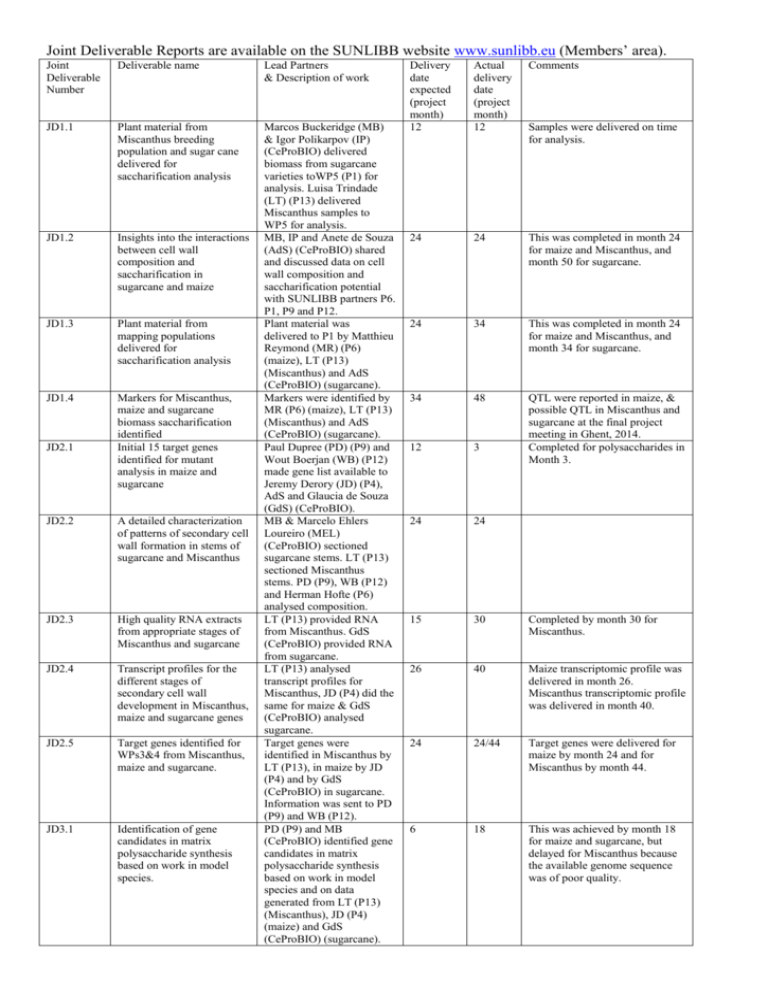
Joint Deliverable Reports are available on the SUNLIBB website www.sunlibb.eu (Members’ area). Joint Deliverable Number Deliverable name Lead Partners & Description of work JD1.1 Plant material from Miscanthus breeding population and sugar cane delivered for saccharification analysis JD1.2 Insights into the interactions between cell wall composition and saccharification in sugarcane and maize JD1.3 Plant material from mapping populations delivered for saccharification analysis JD1.4 Markers for Miscanthus, maize and sugarcane biomass saccharification identified Initial 15 target genes identified for mutant analysis in maize and sugarcane Marcos Buckeridge (MB) & Igor Polikarpov (IP) (CeProBIO) delivered biomass from sugarcane varieties toWP5 (P1) for analysis. Luisa Trindade (LT) (P13) delivered Miscanthus samples to WP5 for analysis. MB, IP and Anete de Souza (AdS) (CeProBIO) shared and discussed data on cell wall composition and saccharification potential with SUNLIBB partners P6. P1, P9 and P12. Plant material was delivered to P1 by Matthieu Reymond (MR) (P6) (maize), LT (P13) (Miscanthus) and AdS (CeProBIO) (sugarcane). Markers were identified by MR (P6) (maize), LT (P13) (Miscanthus) and AdS (CeProBIO) (sugarcane). Paul Dupree (PD) (P9) and Wout Boerjan (WB) (P12) made gene list available to Jeremy Derory (JD) (P4), AdS and Glaucia de Souza (GdS) (CeProBIO). MB & Marcelo Ehlers Loureiro (MEL) (CeProBIO) sectioned sugarcane stems. LT (P13) sectioned Miscanthus stems. PD (P9), WB (P12) and Herman Hofte (P6) analysed composition. LT (P13) provided RNA from Miscanthus. GdS (CeProBIO) provided RNA from sugarcane. LT (P13) analysed transcript profiles for Miscanthus, JD (P4) did the same for maize & GdS (CeProBIO) analysed sugarcane. Target genes were identified in Miscanthus by LT (P13), in maize by JD (P4) and by GdS (CeProBIO) in sugarcane. Information was sent to PD (P9) and WB (P12). PD (P9) and MB (CeProBIO) identified gene candidates in matrix polysaccharide synthesis based on work in model species and on data generated from LT (P13) (Miscanthus), JD (P4) (maize) and GdS (CeProBIO) (sugarcane). JD2.1 JD2.2 A detailed characterization of patterns of secondary cell wall formation in stems of sugarcane and Miscanthus JD2.3 High quality RNA extracts from appropriate stages of Miscanthus and sugarcane JD2.4 Transcript profiles for the different stages of secondary cell wall development in Miscanthus, maize and sugarcane genes JD2.5 Target genes identified for WPs3&4 from Miscanthus, maize and sugarcane. JD3.1 Identification of gene candidates in matrix polysaccharide synthesis based on work in model species. Delivery date expected (project month) 12 Actual delivery date (project month) 12 Comments 24 24 This was completed in month 24 for maize and Miscanthus, and month 50 for sugarcane. 24 34 This was completed in month 24 for maize and Miscanthus, and month 34 for sugarcane. 34 48 12 3 QTL were reported in maize, & possible QTL in Miscanthus and sugarcane at the final project meeting in Ghent, 2014. Completed for polysaccharides in Month 3. 24 24 15 30 Completed by month 30 for Miscanthus. 26 40 Maize transcriptomic profile was delivered in month 26. Miscanthus transcriptomic profile was delivered in month 40. 24 24/44 Target genes were delivered for maize by month 24 and for Miscanthus by month 44. 6 18 This was achieved by month 18 for maize and sugarcane, but delayed for Miscanthus because the available genome sequence was of poor quality. Samples were delivered on time for analysis. JD3.2 Detailed characterization of maize, Miscanthus and sugarcane matrix polysaccharides JD3.3 Identification of additional 30 gene candidates involved in matrix polysaccharide synthesis JD3.4 Identification of activities of 3 new enzymes Five maize or Miscanthus or sugarcane modified lines with altered cell wall polysaccharides characterised JD3.5 JD4.1 Lignin biosynthesis gene orthologues from maize, Miscanthus and sugarcane JD4.2 A catalogue of araomatic molecules from C4 plants: continuous throughout the project JD4.3 Phenolic metabolic maps for maize and sugarcane, integrating transcripts, metabolites and altered fluxes JD4.4 Set of novel target lignin genes in C4 grasses identified through a systems biology approach JD5.1 High-Throughput (HT) saccharification assay established in Brazil JD5.2 HT saccharification assay validated for maize, Miscanthus and sugarcane JD5.3 Miscanthus and sugarcane lines with more digestible biomass identified PD (P9) and MB (CeProBIO) characterized matrix polysaccharides from maize, Miscanthus and sugarcane, using material and data obtained from JD (P4) (maize), LT (P13) (Miscanthus) and GdS (CeProBIO) (sugarcane). JD (P4) and MB (CeProBIO) identified 30 gene candidates involved in matrix polysaccharide synthesis, using data from maize (JD), from Miscanthus (LT) and sugarcane (GdS), and compared with homologous genes in model species by PD (P9). PD (P9) and IP (CeProBIO) identified 3 new enzymes. Maize lines with altered cell wall polysaccharides were provided from JD and characterized by PD (P9), MB (CeProBIO) and Leonardo Gomez (P1). WB (P12) identified Arabidopsis genes involved in lignin biosynthesis. Orthologs of these genes were identified in Miscanthus (LT), maize (JD & MR) and sugarcane (MEL), using previously generated transcriptomic data combined with coexpression data. WB (P12) and MEL (CeProBIO) provided a catalogue of aromatic molecules from maize, Miscanthus and sugarcane. WB (P12), GdS & MEL (CeProBIO) provided phenolic metabolic maps for maize and sugarcane, integrating transcripts, metabolites and altered fluxes. WB (P12), GdS & MEL (CeProBIO) identified a set of novel target lignin genes in C4 grasses, through a systems biology approach. MB, IP (CeProBIO) and LG (P1) established a HT saccharification assay in Brazil. MB (CeProBIO) and LG (P1) validated the HT saccharification assay for biomass samples from maize (MR; P6), Miscanthus (LT; P13) and sugarcane (AdS; CeProBIO). MB (CeProBIO) and LG (P1) identified Miscanthus and sugarcane lines with more digestible biomass 24 30/36 Achieved and completed as reported in D3.2 and D3.3 for maize and Miscanthus (month 30). Sugarcane was completed in month 36. 28 30 Achieved and completed as reported in D3.4 30 30 48 50 See D3.6 12 20 Completed in month 20 for maize. The identification of orthologs was delayed in Miscanthus, due to the poor quality of the genome sequence data available. 30 36 This was completed for maize and Miscanthus in month 30 and updated for sugarcane in month 50. 40 48 40 40 24 24 24 24 36 36 A HT platform was set up in Sao Carlos by IP, and was optimized to deliver a range of functions for biomass characterization. A saccharification assay was established and validated on hundreds of samples of maize, Miscanthus and sugarcane. JD5.4 Detailed description of saccharide products released from biomass of 3 crops JD5.5 Four new cellulases trialled for biomass saccharification JD6.1 A fully-characterised range of hydrophobic molecules from supercritical CO2 extracts of C4 biomass JD6.2 Optimised sCO2 extraction protocols for marketable waxes and other compounds JD6.3 Production of high value phenolic compounds from C4 biomass JD7.1 Lab-scale analysis of 10 integrated process scenarios using maize, Miscanthus and sugarcane In-silico optimization studies from lab-scale data completed JD7.3 JD7.4 Pilot-scale analysis of 3 integrated process scenarios for each species JD7.5 Pilot-scale fermentation of sugars from maize, Miscanthus and sugarcane biomass optimized JD8.1 Biorefinery model workbook JD9.1 Agreement with Brazilian sister consortium signed by using HT saccharification MB (CeProBIO) and LG (P1) provided a detailed description of saccharide products released from maize, Miscanthus and sugarcane biomass IP (CeProBIO) and LG (P1) trialled 4 new cellulases or cellulose cocktails for biomass saccharification MR (P6), LT (P13) and MB (CeProBIO) provided samples of maize, Miscanthus and sugarcane, respectively, to Andrew Hunt (AH) (P1). AH delivered a fully characterized range of hydrophobic molecules from sCO2 extraction of the biomass. AH (P1) optimized sCO2 extraction of marketable waxes and other compounds. Material was provided by MR (maize), LT (Miscanthus) and MB (sugarcane). Biomass was pre-treated using different methods by LG (P1). WB (P12) analysed the products generated to identify valuable lignin monomers and oligomers. Material was provided by MR (maize), LT (Miscanthus) and IP (sugarcane). Paulo Seleghim (PS) (CeProBIO) optimized lab-scale fermentation of sugarcane and investigated the extraction of lignin and lignin breakdown products. 36 36 40 40 20 20 30 30 36 38 24 30 PS (CeProBIO) and Phillip Wright (PW) (P11) carried out optimization studies on lab-scale fermentation data PS and MB (CeProBIO) and David Blomberg (DB) (P8) carried out pilot-scale analysis of 3 integrated process scenarios for maize, Miscanthus and sugarcane Namdar Baghaei-Yazdi (P14), PS and MB (CeProBIO) optimized pilot-scale fermentation of sugars from maize, Miscanthus and sugarcane. Nigel Mortimer (NM) (P7) and PS (CeProBIO) developed a biorefinery model workbook. 30 38 36 48 40 48 24 27 Simon-McQueen-Mason (SMM) (P1) and IP 3 17 Collaboration took place to populate the Biorefinery Model workbook (D8.2) with Brazilian sugarcane data, to produce SUNLIBB Sugar Cane Biorefinery v012.xlxs, for JD8.1 This deliverable was delayed, because the negotiations took all parties JD9.2 Coordination Plan (CeProBIO) coordinated the signing of the agreement between SUNLIBB and CeProBIO. SMM (P1) and IP (CeProBIO) wrote the coordination plan, detailing the Joint Deliverables longer than expected. 3 10 This deliverable was delayed, because the negotiations took longer than expected. Joint Deliverables – Reports Joint Deliverable Number JD1.1 JD1.2 JD1.3 JD1.4 JD2.1 JD2.2 JD2.3 JD2.4 JD2.5 JD3.1 JD3.2 JD3.3 JD3.4 JD3.5 JD4.1 JD4.2 JD4.3 JD4.4 JD5.1 JD5.2 JD5.3 JD5.4 JD5.5 JD6.1 JD6.2 JD6.3 JD7.1 JD7.3 JD7.4 JD7.5 JD8.1 JD9.1 JD9.2 Written up Delivered from Brazil to WP5 month 12 Chemical and morphological characterization of sugarcane bagasse submitted to a delignification process for enhanced enzymatic digestibility. Rezende,C. et al (2011) Biotech for Biofuels 4:54 See JD1.1 Reported at Ghent meeting Sept 2014 (minute 14/148) D2.1 (maize); also done for sugar cane by month 3. D2.2 (maize & Miscanthus); also done for sugar cane by month 24. (e.g. Ghent minutes 14/157 and 14/185) D2.3 (Miscanthus); also done for sugar cane by month 48. D2.4 (Miscanthus); also done for maize (month 24) and sugar cane (month 48); reported at Ghent meeting (minute 14/152) D2.5 (maize & Miscanthus); also done for sugar cane (month 48) Pdf document JD3.1-JD3.4 to download Pdf document JD3.1-JD3.4 to download Pdf document JD3.1-JD3.4 to download Pdf document JD3.1-JD3.4 to download D3.6 Pdf document JD4.1 to download Pdf document JD4.2 to download D4.3 D4.5 Pdf document JD5.1 to download Pdf document JD5.2 to download D5.5 (Miscanthus); also done for sugar cane by month 40. D5.6 D5.8 Pdf document JD6.1 to download Pdf document JD6.2 to download D6.4 D7.2 Word document JD7.3 to download D7.4 D7.5 Excel file JD8.1 to download D9.2 D9.3
